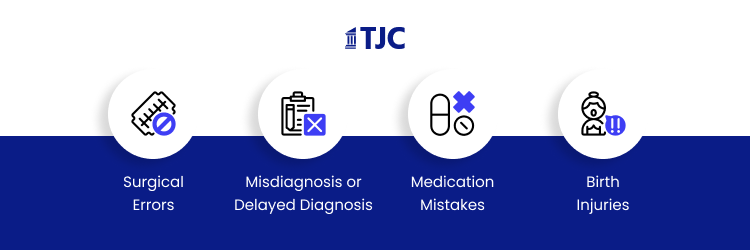When you trust a doctor with your health, you expect quality care. But what happens when that care falls short, causing harm instead of healing? Medical malpractice lawsuits offer a path to justice, accountability, and safety.
High-profile cases like Joan Rivers’ death after surgery or John Ritter’s misdiagnosed condition demonstrate how crucial malpractice laws are. These cases highlight not only the importance of justice but also the public’s demand for medical accountability.
These lawsuits are about more than just winning compensation. They push medical professionals to adhere to the highest standards. This article will explain the legal landscape of medical negligence claims, offering clear guidance on what to expect, how to prove negligence, and the necessary steps to pursue a claim.

Discover Your Potential Compensation
Get an instant estimate for medical malpractice claims
Medical Malpractice Definition
Medical malpractice happens when a healthcare professional fails to meet the standard of care, resulting in harm to the patient. Legally, this means the care given was not what a competent professional would provide under similar circumstances. It’s more than just a mistake; it’s a breach of duty that leads to injury or damage.
Unlike general medical errors, which can occur without negligence, malpractice specifically involves a failure to act with the expected level of skill or care. For instance, this could mean misdiagnosing an obvious condition or making a preventable surgical error. In the U.S., laws such as California’s Civil Code §1714 outline a provider’s duty to act responsibly and with reasonable care.
Common Types of Medical Malpractice

Medical malpractice can take various forms, each with unique legal challenges and evidentiary needs. Here’s a breakdown of the most common types, accompanied by real-life examples.
Surgical Errors
Errors during surgery, like operating on the wrong body part or leaving instruments inside the patient, lead to some of the most serious claims. A notable case occurred when a surgeon performed knee surgery on the wrong knee, highlighting the necessity for meticulous procedural checks.
Misdiagnosis or Delayed Diagnosis
When a medical professional fails to diagnose a condition correctly, the result can be devastating. For instance, misdiagnosing a heart attack as anxiety can delay life-saving care. According to Johns Hopkins Medicine, diagnostic errors impact nearly 795,000 Americans yearly, often leading to preventable complications.
Medication Mistakes
Medication errors can occur at multiple stages, from prescription to administration. Administering the wrong medication or incorrect dosage can result in life-threatening side effects. According to the Food and Drug Administration (FDA), around 100,000 reports in the U.S. are affected by medication errors each year.
Birth Injuries
Birth injuries due to medical negligence can affect an infant’s entire life. Common birth injuries, such as cerebral palsy, can result from delayed C-sections or improper handling. These cases often involve substantial damages, reflecting the lifelong impact of the injury on the child and family.
These cases vary in nature but share one common thread: they stem from deviations in medical care, which cause physical or emotional harm to patients.
What Constitutes Medical Negligence?
Medical negligence occurs when a healthcare provider fails to perform their duty of care, causing harm. To succeed in a medical malpractice claim, a plaintiff must demonstrate four legal elements according to the Medical Malpractice Law:
- Duty of Care: The healthcare provider has a duty to provide care, typically established when a patient-doctor relationship exists.
- Breach of Duty: The provider failed to meet this duty, demonstrating conduct that a reasonably skilled provider would have avoided. For example, not ordering critical tests might qualify as a breach if it leads to harm.
- Causation: There must be a direct link between the breach and the injury. This link requires detailed proof that the injury resulted specifically from the breach and not from an unrelated factor.
- Damages: The harm caused must result in measurable damages, such as medical bills or loss of wages. The plaintiff has to prove these damages through medical records, bills, and even witness statements, showing that the malpractice led to real consequences.
Medical Negligence in Wrongful Death Cases
Wrongful death cases arise when a patient dies due to medical negligence. These cases fit into medical malpractice lawsuits because they claim that the healthcare provider’s actions (or lack of action) directly caused the patient’s death. Unlike typical malpractice claims, wrongful death focuses on the loss suffered by the patient’s family.
In wrongful death cases, families can seek additional damages beyond regular compensation. These include:
- Funeral and Burial Expenses: Costs related to the patient’s passing.
- Loss of Future Income: Compensation for the income the deceased would have earned.
- Loss of Companionship: Financial acknowledgment for losing emotional support and care.
- Pain and Suffering: Damages for the grief and emotional distress experienced by family members.
These cases often involve more complex calculations. Courts consider factors like the deceased’s age, income, and life expectancy to determine appropriate compensation.
Who Can File a Medical Malpractice Lawsuit?
A medical malpractice lawsuit is generally filed by the person directly affected by negligence. However, in cases involving incapacitated or deceased patients, family members or legal representatives are eligible to file on their behalf.
States usually define who qualifies as a representative, typically including spouses, children, or parents. Also, wrongful death suits related to medical malpractice may be filed by family members, with any compensation going directly to the family for losses experienced due to the patient’s passing.
How Long Does a Medical Malpractice Lawsuit Take?
Medical malpractice lawsuits can be lengthy, often stretching from 18 months to several years. The duration depends on several factors:
- Evidence Gathering: Compiling medical records and securing expert testimonies can be time-consuming, and thorough documentation and preparation for court are required.
- Court Scheduling: Delays often occur due to the court system’s backlog, especially in high-demand legal areas.
- Settlement Discussions: Settlement negotiations may extend the timeline, with both sides weighing the benefits of resolving the case early versus going to trial.
According to a recent study, approximately 93% of malpractice cases are resolved through settlements rather than trials, helping to save time and costs for all parties involved.
Filing a Medical Malpractice Lawsuit
Filing a medical malpractice lawsuit involves several key steps:
- Gather Evidence (1-3 Months)
Collect all medical records, bills, and documents showing malpractice. This takes time, as records may not be readily accessible.
- Consult a Lawyer (1-2 Weeks)
Consult with a medical malpractice attorney to review your case. Many attorneys operate on a contingency fee basis, which means they only receive payment if you win your claim.
- Expert Medical Review (1-3 Months)
An expert evaluates your case, confirming if the care was below standard. Some states, like New Jersey, require this before filing.
- File the Claim (1-2 Weeks After Review)
Your lawyer files a formal complaint. Be aware of the statute of limitations deadlines, like one year in California or two years in Texas.
- Pre-Trial Discovery & Negotiation (6-18 Months)
Both sides gather more information. Most cases settle during this phase, avoiding trial.
- Trial (1-3 Weeks)
If there is no settlement, the case goes to trial. Trials take longer and are riskier but can lead to higher compensation.
Key Timelines: Act within state-specific timeframes and consider expert certification requirements. About 93% of cases settle out of court.
Hiring a Medical Malpractice Attorney
Choosing the right attorney can significantly affect a case’s success. Key considerations include the lawyer’s experience, success rate, and familiarity with medical malpractice laws. Attorneys specializing in medical malpractice have insights into specific procedural requirements, expert witness connections, and knowledge of state-specific statutes, strengthening your case.
Statute of Limitations for Medical Malpractice Claims
The statute of limitations sets a deadline for filing a medical malpractice lawsuit. This time limit varies by state. For example, California requires claims to be filed within one year of discovering the injury, while New York allows up to two and a half years from the date of malpractice.
Timing is critical because if you miss the deadline, you lose your right to seek compensation, no matter how serious your case is. Acting quickly also helps preserve evidence, gather medical records, and secure expert testimonies, all strengthening your claim.
Some states have exceptions, like the “discovery of harm” rule. This rule allows more time if the injury isn’t immediately apparent. For instance, in Florida, you can file a claim within two years of discovering the harm, even if it happened years earlier. This exception is crucial for cases where issues like surgical errors or misdiagnoses are only found months or years later.
How to Prove Medical Malpractice: Key Evidences
To prove a medical malpractice case, you need strong, clear evidence. Here’s what’s essential:
Medical Records
This is your primary proof. They show what treatments you received and any mistakes made. For example, if a doctor prescribes the wrong medication, the records will clearly document this error, helping to establish that your care was below standard.
Expert Testimonies
Medical experts are crucial because they explain why your treatment was wrong. They compare your care to what a skilled doctor would have done. For instance, if a condition was misdiagnosed, the expert can testify that a proper diagnosis would have included specific tests that were skipped.
Witness Statements
Statements from nurses, other staff, or family members can strengthen your case. For example, if a nurse saw that important symptoms were ignored, their testimony can help show that the doctor’s actions were negligent. Witnesses add details that might not be obvious from medical records alone.
Medical experts are especially important because they simplify complex medical terms and help the court see exactly where the healthcare provider went wrong. Their insights clarify how negligence occurred and how it led to harm.
Damages You Can Claim in a Medical Malpractice Lawsuit
In a medical malpractice case, you can claim two main types of damages:
Economic Damages
These cover direct costs like:
- Medical Bills: Hospital stays, surgeries, and ongoing treatment (e.g., $80,000 for surgery, $10,000 per year for therapy).
- Lost Wages: Compensation for missed work (e.g., $30,000 for six months of lost income).
Non-Economic Damages
These include compensation for:
- Pain and Suffering: Calculated using a multiplier (e.g., 2-5 times the economic damages). If economic damages are $100,000, a 3x multiplier would result in $300,000.
- Loss of Consortium: Compensation for the impact on family life.
Example Calculation:
Suppose you had surgery that resulted in complications due to malpractice:
- Medical Bills: $80,000
- Ongoing Treatment: $10,000/year for 5 years = $50,000
- Lost Wages: $40,000
- Pain and Suffering Multiplier: 3 (for moderate to severe injury)
Total Economic Damages: $80,000 + $50,000 + $40,000 = $170,000
Total Non-Economic Damages: $170,000 × 3 = $510,000
Total Claim: $170,000 (economic) + $510,000 (non-economic) = $680,000
Informed Consent in Medical Malpractice Cases
Informed consent is a legal requirement that ensures patients understand a medical procedure’s risks, benefits, and alternatives before agreeing to it. It plays a key role in malpractice lawsuits because failing to obtain proper consent can be seen as negligence.
If a patient wasn’t fully informed and suffered harm from undisclosed risks, they may file a claim, arguing that they wouldn’t have agreed to the procedure if they had known all the potential outcomes.
Medical Malpractice Lawsuit Settlement vs. Trial
Choosing between settling a medical malpractice case out of court or going to trial depends on various factors, including time, cost, and desired outcomes.
Settling a Medical Malpractice Case
The settlement means reaching an agreement without going to court. Both parties negotiate a compensation amount, and once the case is settled, it is closed.
Pros:
- Faster Resolution: Settlements typically resolve within 6-12 months, avoiding a lengthy legal process.
- Lower Legal Costs: Costs can range from $10,000 to $30,000, much less than trial expenses.
- Privacy: The details remain confidential, unlike a public trial.
Cons:
- Lower Compensation: Settlements may offer $300,000–$500,000, compared to potentially higher trial awards.
- No Admission of Guilt: The provider doesn’t admit fault, which may not offer closure.
Going to Trial
Going to trial means presenting the case before a judge or jury. It involves detailed evidence, witness testimonies, and a final verdict that can be appealed.
Pros:
- Higher Potential Compensation: Juries may award $1 million or more, including punitive damages.
- Accountability: A trial verdict can publicly establish fault, promoting accountability.
Cons:
- Lengthy Process: Trials can take 2-4 years to resolve.
- Higher Costs: Legal fees and expenses can reach $50,000 to $150,000.
- Emotional Strain: Preparing for trial can be stressful and emotionally taxing.
Common Defenses in Medical Malpractice Lawsuits
Doctors and hospitals often use several defenses to challenge medical malpractice claims. Here are the most common:
- Standard of Care Defense: The defense argues that the medical care provided met the accepted standards. They claim that the treatment was consistent with what any competent professional would have done under similar circumstances, often supported by expert witnesses.
- Pre-Existing Condition: The healthcare provider may argue that the injury or condition was due to a pre-existing issue rather than any negligence. This defense claims that even if there was an error, it did not directly cause harm.
- Contributory Negligence: In some cases, the defense might argue that the patient’s own actions contributed to or worsened their condition. For example, failing to follow post-operative care instructions could be cited as contributory negligence, reducing the healthcare provider’s liability.
- Assumption of Risk: If a patient was informed about the potential risks of a treatment or procedure and still chose to proceed, the defense might use this to argue that the patient assumed the risks knowingly, minimizing the provider’s liability.
Medical Malpractice Lawsuits FAQs
What Are The Chances Of Winning A Medical Malpractice Lawsuit?
Winning a medical malpractice claim depends on the strength of your evidence, the expertise of your medical malpractice lawyer, and the persuasiveness of expert testimonies. Generally, a well-prepared case with solid documentation has a higher chance of success. According to studies, plaintiffs win about 27% of cases that go to trial, but settlements can be reached in many cases beforehand.
Can I Sue If I Signed A Consent Form?
Yes, you can still file a lawsuit even if you signed a consent form. Signing a form does not absolve healthcare providers from maintaining the appropriate standard of care. If the provider acted negligently or failed to inform you adequately about the procedure’s risks, your medical malpractice liability claim remains valid.
What Is The Most Common Malpractice Suit?
Misdiagnosis or delayed diagnosis is one of the most common types of medical malpractice claims. Failure to diagnose conditions like cancer, heart disease, or infections can lead to severe consequences and form the basis for many successful lawsuits. Timely and accurate diagnosis is critical for effective medical care, and failures in this area often lead to legal action.
Do All Cases Go To Trial?
No, not all cases go to trial. In fact, most medical malpractice settlements are reached out of court, with both parties negotiating a compensation amount to avoid the uncertainties and costs of a trial. Settling can be advantageous because it provides a quicker resolution, which might result in lower compensation than a trial verdict.
What Is The Average Payout For Medical Negligence In The US?
The average payout for medical negligence claims varies, but figures range between $300,000 and $500,000. Severe cases, particularly those involving long-term disability or wrongful death, can lead to much higher compensation. Medical malpractice insurance often covers these payouts, but the final amount depends on factors like the extent of the damage and jurisdictional laws.
Can I Still File A Lawsuit If The Doctor Corrected The Mistake?
Yes, you can still file a lawsuit even if the doctor corrected the mistake later. Correcting an error does not erase the initial negligence, especially if the harm has already been done. The medical professional remains responsible for the initial lapse, and any compensation would be calculated based on the damages caused before the correction.
How Much Does Hiring a Medical Malpractice Lawyer Cost?
Most medical malpractice attorneys operate on a contingency fee basis, which means they only receive payment if you win or settle the case. The standard contingency fee can range from 25% to 40% of the settlement or court award. This arrangement makes legal representation more accessible, though clarifying fee structures upfront is essential to avoid surprises.
Can I Sue for Medical Malpractice If I Am Not a US Citizen?
Yes, non-citizens can file medical negligence claims in the U.S. if the malpractice occurred within the country. Citizenship does not impact your ability to pursue justice under medical malpractice law; the focus remains on the occurrence of negligence and its effects on the patient.
Does Medical Malpractice Affect the Doctor’s License?
A successful medical malpractice claim can result in various outcomes for the doctor, including disciplinary actions or loss of license, depending on the severity of the negligence. State medical boards review these cases and determine if the practitioner violated professional standards, which can lead to sanctions, license suspension, or revocation.
What Are Punitive Damages in Medical Malpractice Cases?
Punitive damages go beyond compensating the patient for their injuries. They are intended to punish the healthcare provider for particularly reckless or malicious behavior. While not awarded in every case, they can significantly increase the compensation if the court determines that the actions warrant extra accountability.
Conclusion
Medical malpractice can be overwhelming, but understanding how it works is the first step toward justice. We’ve covered medical malpractice, the types of negligence that qualify, and the steps to file a lawsuit. We also discussed the importance of evidence, damages you can claim, and the choice between settling and going to trial.
If you believe you’ve been harmed by medical negligence, don’t wait. Timing is critical due to strict filing deadlines. Reach out to an experienced medical malpractice lawyer who can guide you through the process and help you understand your rights.
Taking action isn’t just about compensation. It’s about holding healthcare providers accountable and preventing future mistakes.
Disclaimer: The information provided in this article is for informational purposes only and does not constitute legal advice. Readers should not act or refrain from acting based on this information without seeking appropriate legal counsel from a licensed attorney. The content is not intended to create, and receipt or viewing of it does not establish an attorney-client relationship.


